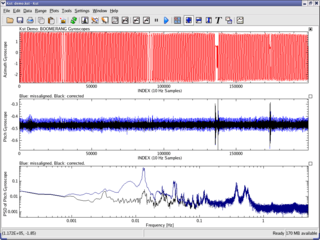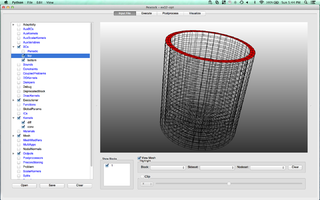troff, short for "typesetter roff", is the major component of a document processing system developed by Bell Labs for the Unix operating system. troff and the related nroff were both developed from the original roff.

Vector graphics are a form of computer graphics in which visual images are created directly from geometric shapes defined on a Cartesian plane, such as points, lines, curves and polygons. The associated mechanisms may include vector display and printing hardware, vector data models and file formats, as well as the software based on these data models. Vector graphics are an alternative to raster or bitmap graphics, with each having advantages and disadvantages in specific situations.

The World Wide Web is an information system that enables content sharing over the Internet through user-friendly ways meant to appeal to users beyond IT specialists and hobbyists. It allows documents and other web resources to be accessed over the Internet according to specific rules of the Hypertext Transfer Protocol (HTTP).

gnuplot is a command-line and GUI program that can generate two- and three-dimensional plots of functions, data, and data fits. The program runs on all major computers and operating systems . Originally released in 1986, its listed authors are Thomas Williams, Colin Kelley, Russell Lang, Dave Kotz, John Campbell, Gershon Elber, Alexander Woo "and many others." Despite its name, this software is not part of the GNU Project.
DOT is a graph description language, developed as a part of the Graphviz project. DOT graphs are typically stored as files with the .gv or .dot filename extension — .gv is preferred, to avoid confusion with the .dot extension used by versions of Microsoft Word before 2007. dot is also the name of the main program to process DOT files in the Graphviz package.

ROOT is an object-oriented computer program and library developed by CERN. It was originally designed for particle physics data analysis and contains several features specific to the field, but it is also used in other applications such as astronomy and data mining. The latest minor release is 6.28, as of 2023-02-03.
In Linux systems, initrd is a scheme for loading a temporary root file system into memory, to be used as part of the Linux startup process. initrd and initramfs refer to two different methods of achieving this. Both are commonly used to make preparations before the real root file system can be mounted.

Kst is a plotting and data viewing program. It is a general purpose plotting software program that evolved out of a need to visualize and analyze astronomical data, but has also found subsequent use in the real time display of graphical information. Kst is a KDE application and is freely available for anyone to download and use under the terms of the GPL. It is noted for being able to graph real-time data acquisition.
The CERN Program Library (CERNLIB) is a collection of general purpose software libraries and program modules for scientific computing, developed at the European Organization for Nuclear Research CERN. The application area of the library focuses on physics research, in particular high energy physics, involving general mathematics, data analysis, detectors simulation, data-handling, numerical analysis, and others, applicable to a wide range of scientific problems. Many modules are written in the FORTRAN 77 language.
Metaphor Computer Systems (1982–1994) was an American computer company that created an advanced workstation, database gateway, unique graphical office interface, and software applications that "seamlessly integrate" data from both internal and external sources. The Metaphor machine was one of the first commercial workstations to offer a complete hardware/software package and a GUI, including "a wireless mouse and a wireless five-function key pad". Although the company achieved some commercial success, it never achieved the fame of either the Apple Macintosh or Microsoft Windows.
Open Source Physics, or OSP, is a project sponsored by the National Science Foundation and Davidson College, whose mission is to spread the use of open source code libraries that take care of a lot of the heavy lifting for physics: drawing and plotting, differential equation solvers, exporting to animated GIFs and movies, etc., tools, and compiled simulations for physics and other numerical simulations. The OSP collection provides curriculum resources that engage students in physics, computation, and computer modeling. The core library is in the Java programming language and licensed with GNU General Public License licenses. The site now serves over 10,000 visitors per month. The Open Source Physics Project is an extension of the Physlet Project.

EAS3 is a software toolkit for reading and writing structured binary data with geometry information and for postprocessing of these data. It is meant to exchange floating-point data according to IEEE standard between different computers, to modify them or to convert them into other file formats. It can be used for all kinds of structured data sets. It is mainly used in the field of direct numerical simulations.
Computational particle physics refers to the methods and computing tools developed in and used by particle physics research. Like computational chemistry or computational biology, it is, for particle physics both a specific branch and an interdisciplinary field relying on computer science, theoretical and experimental particle physics and mathematics. The main fields of computational particle physics are: lattice field theory, automatic calculation of particle interaction or decay and event generators.
MINUIT, now MINUIT2, is a numerical minimization software library developed at the European Organization for Nuclear Research (CERN). It provides several algorithms that search for parameter values that minimize a user-defined function, and compute confidence intervals for the parameters by scanning the function near the minimum.

UGENE is computer software for bioinformatics. It works on personal computer operating systems such as Windows, macOS, or Linux. It is released as free and open-source software, under a GNU General Public License (GPL) version 2.
Simcenter Amesim is a commercial simulation software for the modeling and analysis of multi-domain systems. It is part of systems engineering domain and falls into the mechatronic engineering field.

MOOSE is an object-oriented C++ finite element framework for the development of tightly coupled multiphysics solvers from Idaho National Laboratory. MOOSE makes use of the PETSc non-linear solver package and libmesh to provide the finite element discretization.
DaviX is an open-source client for WebDAV and Amazon S3 available for Microsoft Windows, Apple MacOSX and Linux. DaviX is written in C++ and provide several command-line tools and a C++ shared library.

CAINE Linux is an Italian Linux live distribution managed by Giovanni "Nanni" Bassetti. The project began in 2008 as an environment to foster digital forensics and incidence response (DFIR), with several related tools pre-installed.










